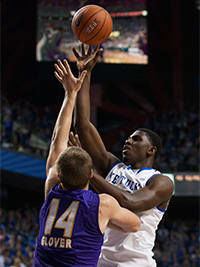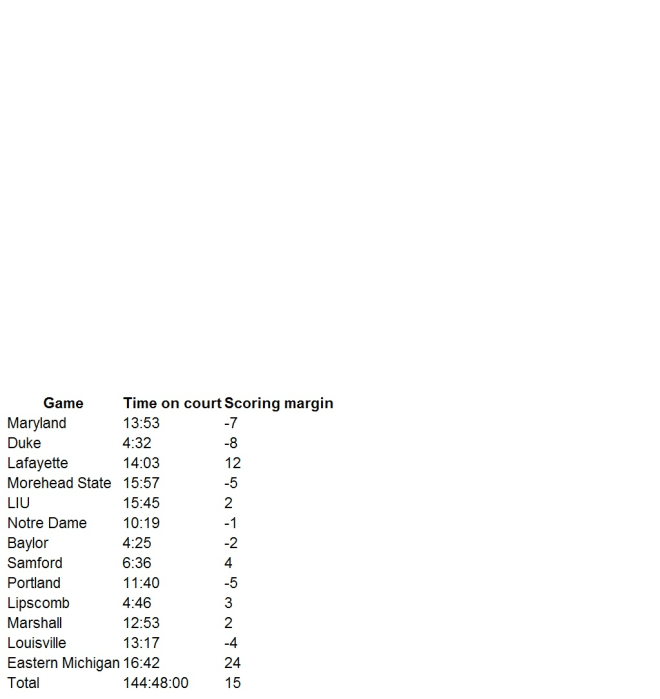A look at Kentuckys frontcourt as SEC play begins

Kentucky opens Southeastern Conference play Thursday night at Vanderbilt. With the nonconference portion of the schedule complete, a look at the progress of the Wildcats' frontcourt through 13 games.
Advertisement
Key stats: 10.3 ppg, 9.3 rpg, 45 blocks
We know how good Noel is on defense. He's recording blocks and steals at an historic rate, making him one of the best defenders in the country.
All that activity, however, has left him a bit foul-prone. Noel is still susceptible to pump fakes, and he's going to pick up more fouls simply by going for more blocks, steals and charges than some of his counterparts.
But he has to be careful - he can (obviously) only make an impact on a game if he's able to be in the game.
Here's how Noel's fouling stacks up to the rest of the NCAA top-5 blocks leaders - with Anthony Davis' mark thrown in for good measure. One of Davis' best traits was being able to avoid foul trouble.
Can Noel bring that number down? He's only fouled out once so far, against Lipscomb, but he will get tested by SEC post players who will be looking to get him to the sidelines.
Key stats: 7.8 ppg, 5.9 rpg, 27 blocks
Cauley-Stein has provided Calipari with a valuable second center, averaging 7.8 points and 5.9 rebounds in 20.5 minutes. But he's more than just a switch-him-out-for-the-starter kind of guy; he and Noel are versatile and skilled enough to share space on the court.
We heard so much hype about the "twin towers" lineup before the season. How's it turning out so far? Well, there's mixed results. The amount of time they're in the game together has fluctuated significantly game-to-game. They average about 11 minutes per game together. All told, a lineup featuring both Noel and Cauley-Stein has played 27.8 percent of UK's total minutes.
But how effective are they? Overall, those lineups in those time spans have outscored their opponents by a combined 15 points - but that number is inflated by a plus-24 margin against Eastern Michigan.
If you take away that game, lineups featuring the two centers have had a positive net margin in only five other games and hold an overall -9 margin. While the defense is improved with those two on the court, they may take more away than they provide.

Key stats: 12.0 ppg, 4.8 rpg, 43.4 3FG pct.
Wiltjer was supposed to take on a more important, expanded role coming into this season.
On one account of that, he's been successful. He's more than doubled his minutes played and how many shots he's taking.
Last year, as the clear-cut seventh man, he took 7.2 percent of his team's total shots. This year, he's taken 15.7 percent of the team's shots.
But he hasn't expanded his offensive game at all. In fact, he's only become more one-dimensional.
In his freshman year, exactly 50 percent of his shots were 3-pointers; this season, 62.8 percent of his shots come from behind the arc.
His accuracy is virtually unchanged - he's shooting 0.2 percent better so far this year.
Wiltjer talked about improving his game by going inside more, but so far, he's only lived more on the perimeter.
Key stats: 14.0 ppg, 6.3 rpg, 64.2 FG pct.
Poythress has quickly become this year's most enigmatic player. He clearly has huge potential, but has only shown it in flashes.
His stats, on the surface, look good. He's second on the team with 14 points per game, and his 64.2 field-goal percentage ranks in the nation's top 10.
But it still seems like he should be doing so much more. Against teams that he should be able to dominate, he's had quiet games.
His inconsistent motor is maddening to Calipari, who has said that Poythress can only compete in bursts of a couple minutes at a time.
It shows in rebounding (Poythress is averaging 6.3 per game) and in mental mistakes (Poythress has 35 turnovers on the year, second-most on the team and a number that's too high for a player who's not a primary ball-handler).
It also shows in Poythress' offensive efficiency rating, which is significantly different against UK's five high-quality opponents than against other teams:
Against Maryland, Duke, Notre Dame, Baylor, Louisville: average offensive rating of 88, with four games under 100.
Against the rest: Average offensive rating of 105, with just one game under 100.
According to Ken Pomeroy's player similarity score - which takes 13 statistical categories to cross-reference overall player production - Poythress' top three matches are the freshman seasons for: Durrell Summers (Michigan State), Davon Jefferson (Southern California) and Jordan Morgan (Michigan).
Not exactly a group that stands out, and not exactly a group that Poythress, given his potential, should be in.